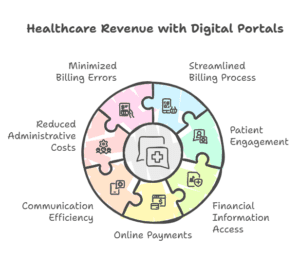In today’s digital age, healthcare organizations are increasingly turning to technology to streamline operations, improve patient satisfaction, and boost financial performance. One such technology is the digital patient portal, which allows patients to access their health information, schedule appointments, communicate with providers, and make payments all from the convenience of their smartphones or computers.
Digital patient portals not only improve patient engagement and communication but also play a significant role in improving revenue collection for healthcare organizations. By enabling patients to manage their accounts online, these portals enhance billing processes, reduce administrative burdens, and ensure timely payments. Let’s explore how digital patient portals are transforming revenue collection in healthcare.
Why Digital Patient Portals Are Crucial for Revenue Collection
Revenue collection in healthcare can be a complex and time-consuming process, involving multiple touchpoints between patients, providers, and insurance companies. Delays in payment or confusion about financial responsibilities can lead to slow reimbursement cycles and increased accounts receivable. Digital patient portals help streamline this process by providing patients with immediate access to their billing information and payment options. Key benefits include:
- Convenient payment methods: Patients can view their balances, make payments, and set up payment plans at their convenience, leading to faster collection times.
- Clear financial communication: Patients have direct access to billing statements, reducing confusion about what is owed and how payments should be made.
- Increased transparency: By allowing patients to see their outstanding charges and insurance status, patient portals reduce misunderstandings and disputes over billing.
How Digital Patient Portals Improve Revenue Collection

1. Smooth Billing and Payment Processes
One of the most significant advantages of digital patient portals is that they simplify the billing and payment process for both patients and healthcare providers. Benefits include:
- Online bill viewing and payment: Patients can view their bills, check insurance coverage, and make payments online, leading to quicker payment cycles and reduced administrative workload.
- Payment reminders: Automated reminders sent through the portal encourage patients to pay their bills on time, reducing overdue payments and increasing cash flow.
- Self-service payment options: Patients can make payments directly through the portal, including credit card or bank transfer options, giving them the flexibility to pay on their terms.
2. Reducing Administrative Burden
Handling billing inquiries, processing payments, and managing paper statements can be time-consuming for healthcare organizations. By integrating digital patient portals, healthcare organizations can reduce administrative work and focus on providing quality care. Key benefits include:
- Reduced call volume: With patients able to access billing information through the portal, the volume of calls to the billing department is reduced, freeing up staff to handle more complex tasks.
- Faster claim processing: Digital portals streamline the process of submitting payment information and verifying insurance details, ensuring that claims are processed faster and payments are received more quickly.
- Automated statements: Statements and invoices are automatically generated and sent to patients, saving time and reducing errors compared to manual paper-based billing systems.
3. Offering Flexible Payment Plans
Digital patient portals make it easier for healthcare organizations to offer flexible payment plans, allowing patients to pay off large bills over time. This increases the likelihood of full payment and improves patient satisfaction. Benefits include:
- Customized payment schedules: Patients can choose a payment schedule that fits their budget, whether it’s monthly, quarterly, or based on their insurance reimbursements.
- Clear payment tracking: Patients can track their payments in real-time through the portal, ensuring that both they and the healthcare provider are on the same page regarding payment status.
- Automated reminders for installment payments: Automated reminders for upcoming payments keep patients on track and reduce the risk of missed payments.
4. Improving Patient Transparency
Transparency is a crucial element in building trust between healthcare providers and patients. Digital patient portals promote transparency by providing patients with easy access to their billing information, insurance details, and payment history. Key benefits include:
- Access to insurance information: Patients can see what their insurance will cover and what they are responsible for paying, reducing confusion and improving payment compliance.
- Real-time billing updates: As charges and payments are applied, patients can view their balances in real-time, making it easier to manage payments and understand their financial responsibilities.
- Clear breakdown of charges: Detailed statements and itemized lists of services allow patients to better understand what they are paying for, reducing disputes and complaints.
5. Reducing Denied or Delayed Payments
One of the challenges in healthcare revenue collection is dealing with denied or delayed payments, often due to incomplete or incorrect billing information. Digital patient portals help reduce these issues by providing patients with access to accurate and up-to-date billing details. Benefits include:
- Real-time claims status tracking: Patients can check the status of their claims through the portal and identify issues before they become problems.
- Fewer billing disputes: With transparent and accurate billing information, patients are less likely to dispute charges, leading to faster resolution of payment issues.
- Streamlined claim submissions: Healthcare organizations can submit claims more efficiently through the portal, reducing the chances of errors that result in claim denials.
6. Enhancing Patient Engagement and Satisfaction
When patients feel involved and informed about their healthcare and financial situation, they are more likely to be engaged in their treatment and more willing to pay their bills on time. Digital patient portals play a key role in enhancing patient engagement and satisfaction. Key benefits include:
- Easy access to medical records: Patients can view their medical history, test results, and treatment plans, fostering a sense of involvement in their care.
- Improved communication: Patients can communicate directly with healthcare providers through the portal, asking questions or addressing concerns about their treatment or billing.
- Increased patient loyalty: By providing an easy-to-use, patient-centered platform, healthcare organizations can build stronger relationships with patients, improving overall satisfaction and payment compliance.
Why Healthcare Organizations Should Embrace Digital Patient Portals
Digital patient portals are an essential tool for improving revenue collection in healthcare organizations. By simplifying billing processes, offering flexible payment options, reducing administrative burdens, and improving transparency, patient portals enhance both financial and operational performance. Key reasons to embrace digital patient portals include:
- Faster and more accurate payments.
- Increased operational efficiency.
- Enhanced patient engagement and satisfaction.
- Better revenue cycle management.
Conclusion
Digital patient portals are revolutionizing the way healthcare organizations manage revenue collection. By offering convenient payment options, reducing administrative burdens, and improving transparency, these portals help ensure faster payments and more satisfied patients. Healthcare providers who embrace digital patient portals can streamline their revenue cycle processes, increase cash flow, and improve patient experiences, leading to a more sustainable and successful practice.
What People Are Asking
1. How do digital patient portals improve revenue collection?
Digital patient portals streamline billing and payment processes, reduce administrative work, and provide patients with easy access to their financial information, leading to faster payments and fewer payment delays.
2. How do digital patient portals reduce billing disputes?
By providing transparent, real-time billing information and clear breakdowns of charges, digital patient portals reduce misunderstandings and prevent billing disputes.
3. Can digital patient portals offer flexible payment options?
Yes, digital patient portals enable healthcare organizations to offer customized payment plans, allowing patients to pay bills over time and track their payments easily.
4. How do digital patient portals improve patient satisfaction?
By offering easy access to medical records, transparent billing, and direct communication with healthcare providers, patient portals improve patient engagement and satisfaction.
5. How do digital patient portals help with insurance verification?
Digital patient portals allow patients to check their insurance coverage, see what is covered, and understand what they are responsible for paying, reducing confusion and improving payment compliance.
Disclaimer
For informational purposes only; not applicable to specific situations.
For tailored support and professional services,
please contact Staffingly, Inc. at (800) 489-5877
Email: support@staffingly.com.
About This Blog: This Blog is brought to you by Staffingly, Inc., a trusted name in healthcare outsourcing. The team of skilled healthcare specialists and content creators is dedicated to improving the quality and efficiency of healthcare services. The team passionate about sharing knowledge through insightful articles, blogs, and other educational resources.
 Book a Demo to Build Your Team Today!
Book a Demo to Build Your Team Today!

 Read Case Studies
Read Case Studies 



 Virtual Medical Assistants
Virtual Medical Assistants



